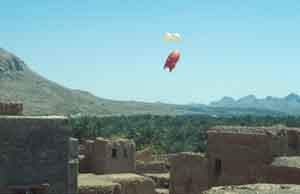|
Oases are a particular strategy of human adaptation to a harsh environment which played a crucial role in the history of man on the Arabian Peninsula over the past five centuries. In the world of late 20th century with its extraordinary industrial and technological developments oases with their agricultural basis have ceased to play their former role. Therefore, it is of great importance to document the old traditions and to investigate the possibilities of making use of the old settlements for tourism and other purposes, which have to be integrated into the overall development plans for Oman's oases.
Since 1999 an interdisciplinary project, entitled "Transformation Processes in Oasis Settlements in the Sultanate of Oman" was undertaken by orientalists, ethnologists, architects, urban planners, plant physiologists, computer specialists and archaeologists from the university in Tübingen, Hohenheim, Stuttgart and Muscat, as well as from the Orient Department of the German Institute of Archaeology in Berlin and with the financial support of the state of Baden-Württemberg, the Sultan Qaboos University in Muscat and the German Institute of Archaeology.
|
|
The research is focused on processes of transformation throughout history, regarding the architecture and material culture, the economy and ecology of the oasis settlements in a regional and interdisciplinary approach. The aim of the archaeological study is the investigation of the settlement in respect to their beginning and development as well as their ecological setting.
|
|
The area under study lies in the Al Hajar massif, in the form of a circa 35 km long transection, that extends from Al Hamra through the Wadi Bani 'Awf to the road Al Rustaq - Awabi.
It was chosen for investigation due to its delimited nature as settlement area, which would allow investigation to be completed within two years, on one hand. On the other, the inhabitants still continue traditional customs and economy, which enables the documentation of traditional forms of living. With the exception of the environs of Al Hamra, this area has not been examined archaeologically until now.
|
|
Various scientific methods were used for the archaeological survey of the area under study.
|
|
The survey has been prepared by studying aerial photographs of the National Survey Authority of the Sultanat Oman. Many features could be recognised and were marked on the photographs. Later, all of these points were visited during our field survey, and the different find spots were recorded with a Global Positioning System (GPS).
|
|
The aerial photographs were also used to draw up maps of the study area with the help of a special computer software. All archaeological sites have been marked on these maps.
|

Taking aerial photographs with a balloon at Al Hamra
|
After an inspection of our study area we decided to take photographs of the most important deserted settlements at a low altitude with the help of a balloon. These photographs were used to draw sketch plans of these sites. On the basis of these plans it is possible to investigate the architecture of the old villages.
|
|
However, most important was the collection of pottery sherds, for they are a great assistence in dating the ancient tombs and settlements. We scrutinize the sherds to find out the methods of production and exchange systems, among others.
|
|
The oldest archaeological remains in the Wadi Bani ´Awf can be dated to the 3rd millennium B.C. These are large overground stone tombs of the beehive/Hafit-type. However, no settlement ruins have been found from this period. At this time the area was presumably used as pasture, and the camp sites of the shepherds have disappeared.
The settlement occupation of the Wadi Bani ´Awf began in the Early Iron Age (1100-600 B.C.). Balad Seet is probably the most ancient settlement in the Wadi. According to the pottery finds, this site was inhabited from the Early Iron Age until today. Only pottery sherds but no architectural remains of the ancient periods have survived due to continuous habitation at the site.
The lower parts of the Wadi Bani ´Awf have been occupied since the Early Islamic Period (630-1055 A.D.) and increasingly since the Middle Islamic Period (1055-1500 A.D.). All domestic architectural remains in the Wadi can be assigned to the Late Islamic Period (1500-1750 A.D.) or to modern times.
The Al Hamra region was probably settled during the Early Iron Age (1100-600 B.C.) for the first time. Two settlement ruins of this period have been found south of the modern town of Al Hamra. In the vicinity many tombs of different types but probably the same date have been discovered as well.
However, no remains of the following Late Iron Age (300 B.C.-660 A.D.) could be found.
Settlement activities seem to have started again in the Early Islamic Period (660-1155 A.D.). Pottery of this period was found close to the Hisn Khawr tower which is situated on a small hill south of Al Hamra. On the slopes of this hill old settlement ruins have been discovered which can be dated to the Late Islamic Period (1500-1750 A.D.) and probably even earlier, that is the Middle Islamic Period (1155-1500 A.D.). An old mosque is locted at the foot of the hill.
The town of Al Hamra was founded at the end of the 17th century A.D. No ancient ruins or even pottery of earlier periods have been found in the town itself.
|
